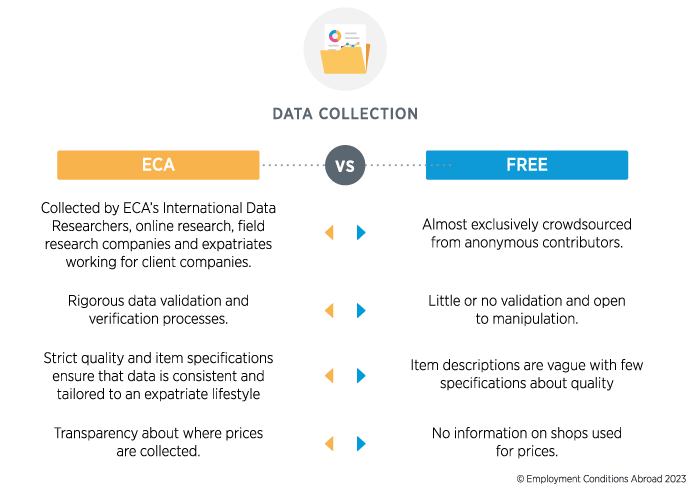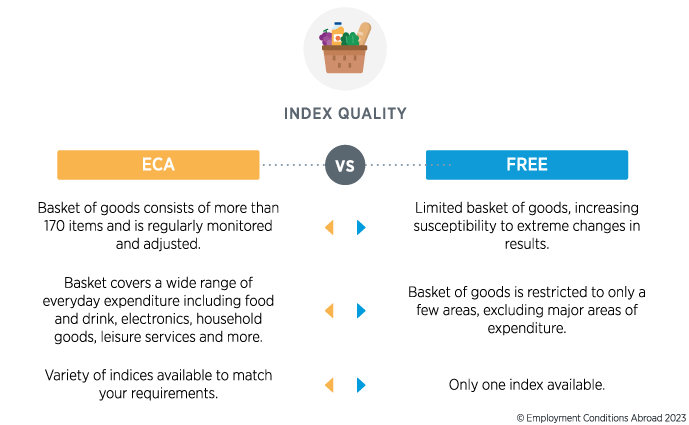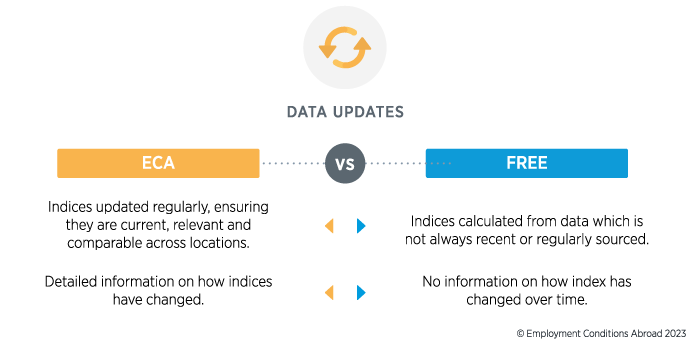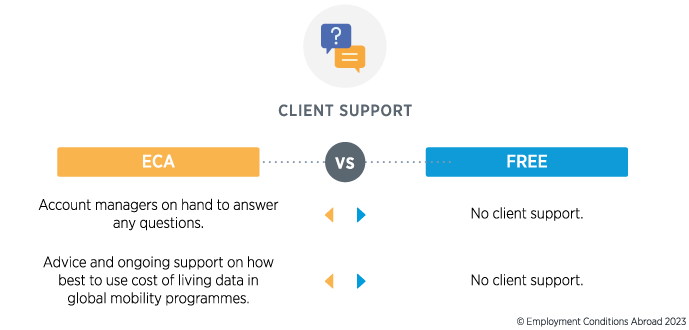With so much free and easily accessible information online, is it worth paying for cost of living data? It is no secret that free, crowdsourced cost of living information exists online and we commonly receive questions about how our data compares to such sources. Below we explain why free-to-access data should be used with caution and why you can rely on ECA’s 50 years of experience to provide cost of living data to calculate international assignee pay with confidence.

Websites that provide free cost of living data typically rely on crowdsourced information to make their comparisons. These sites allow visitors to contribute as much or as little information as they like about how much a basket of goods and services costs in a particular city. The data submitted is often verified algorithmically and could be easily manipulated. They make little attempt to ensure that the goods priced are of a consistent quality, size and specification, and do not distinguish between prices contributed by locals, expats, tourists or even those with no experience of the city at all.
The data used in ECA’s cost of living calculations is based on a multi-source approach, collected by our own International Data Researchers (IDRs), online research, field research companies and expatriates working for client companies. Before we use our data to calculate cost of living indices, we conduct rigorous verification to ensure that it matches our specifications, is inclusive of any sales tax or tips it may be subject to and consistent with previous data.
The stores visited and the brands and services included in ECA’s price analysis are tailored specifically to the shopping habits of expatriates using information provided by IDRs and our clients’ assignees. We target high quality items and international brands that meet our item specification criteria to ensure that our data is truly relevant to international assignees and to enable us to make accurate cost comparisons across locations.

Another issue to be considered when using crowdsourced websites is the extent to which the basket of goods used in the calculations truly reflects all areas of an assignee’s day-to-day expenditure. As mentioned above, such sites rely almost exclusively on user contributions for their price data. As a result, it is in their interest to use a restricted basket of goods to encourage contributions and to ensure enough prices are available to calculate an index. In practice, this means that crowdsourcing sites tend to not only use a small basket of goods, but also one that neglects key areas of everyday expenditure and so cannot be relied upon to calculate a true representation of assignee living costs.
In contrast to this, ECA’s cost of living basket consists of more than 170 goods and services and counting. The basket of goods that goes into our calculations covers a wide range of areas of everyday expenditure including a large selection of food and drink items, electronics, household goods, leisure services and much more, allowing far more accurate comparisons of overall living costs between two locations.
Furthermore, ECA publishes three index types which use different assumptions about shopping habits and spending patterns so you can choose the one most appropriate for your assignments. Each one can be adjusted to include or exclude areas of expenditure such as motoring costs or utilities to match your company’s philosophy and policies. In comparison, crowdsourced indices tend to use a one-size-fits-all approach aimed at a wide target audience rather than focusing on the more nuanced needs of global mobility programmes.

We recognise that it is important for clients to know their data is as up-to-date as possible and defensible should assignees have questions about their cost of living provision. This is why our cost of living indices are updated regularly, over a strict timeframe to ensure that results are as current, relevant and comparable as possible. Surveys are conducted at least twice a year for all locations, and more regularly for high inflation locations, so you can always be sure that our results provide an up-to-date snapshot of comparative everyday living costs. We also publish explanations of how price changes and exchange rate movements have caused the indices to change since the last survey to assist with assignee queries.
Sites that offer crowdsourced cost of living data lack reliable, consistent data and their indices can change at any time. This makes it difficult to pinpoint how up to date the data is and when it will change again, and no explanations are given about the changes. This can make assignee queries challenging to deal with, especially as they may be able to present you with a different index while referring to the same free-to-view source.

Finally, in addition to the reliability and transparency that ECA offers, it is important to consider the wealth of extra support that we can provide that is simply non-existent from free providers. Subscribers to ECA data have dedicated account managers on hand to help with all aspects of our cost of living data. Whether it is providing explanations for how results have been calculated, detailing how and why results have changed over time, or giving advice on how best to implement the results, we work alongside our clients every step of the way to ensure they get the most from our data.
FIND OUT MORE
ECA publishes cost of living data for more than 500 locations around the world. Learn more about ECA’s cost of living data by downloading our FREE cost of living white paper which explains how ECA's indices are calculated and applied to protect the buying power of people moving between countries as well as looking at what causes them to change over time.
It is available from ECA as part of a subscription or as one-off calculations. It is also built in to ECA’s Build-up, Net-to-Net and Cost-estimate calculators which enable calculations in seconds. Cost of living data is also pre-populated in ECAEnterprise, our Assignment Management System.
Please contact us to speak to a member of our team directly.